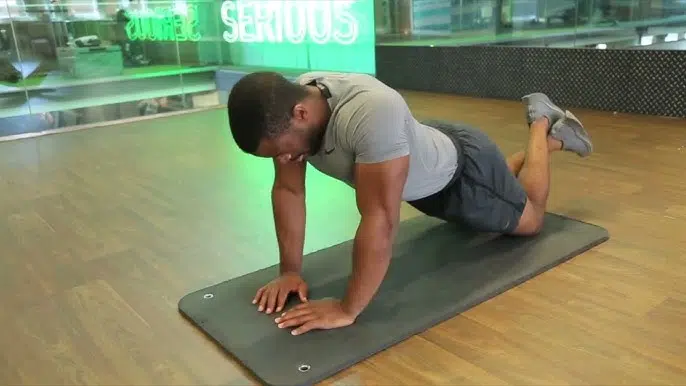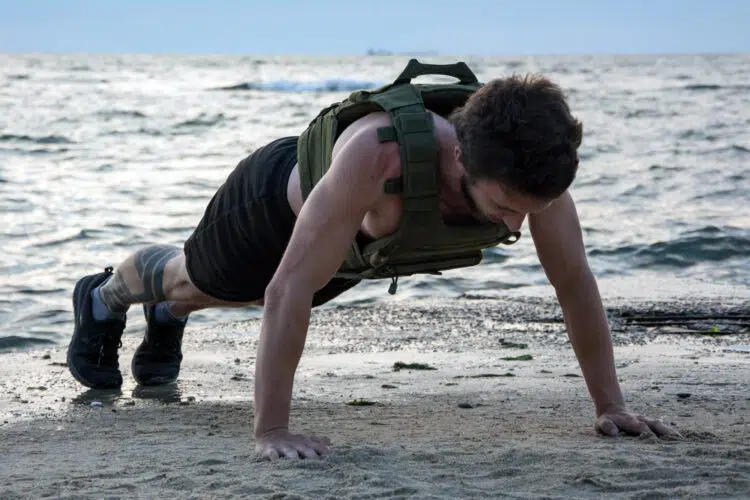Push-ups are probably the most commonly performed exercise on the planet. From kids in PT class to Olympic athletes, push-ups are a fitness staple. The reasons for this popularity are threefold: Push-ups are effective, accessible, and modifiable.
Effective: Push-ups work your chest, shoulders, and triceps. Performed close to failure, push-ups are as potent as bench presses for building muscle and strength (1).
Accessible: Need a workout but can’t get to the gym? Just pump out some push-ups. Requiring very little space and no equipment, push-ups are the ultimate excuse-free exercise.
Modifiable: It doesn’t matter if you are a beginner or an elite exerciser, there is a push-up variation for you. Beginners can do incline or kneeling push-ups, while more experienced people can try one-armed, decline, or handstand push-ups.

I’m a veteran personal trainer, and I often include push-ups in my client’s workouts. I use them in conjunction with conventional chest exercises to help my clients reach their fitness, strength, and muscle-building goals.
Level Up Your Fitness: Join our 💪 strong community in Fitness Volt Newsletter. Get daily inspiration, expert-backed workouts, nutrition tips, the latest in strength sports, and the support you need to reach your goals. Subscribe for free!
However, I don’t just prescribe push-ups in straight sets, e.g., 2 sets of 15 or 3 sets of 20. Instead, I use unusual methods and set/rep schemes to make their training even more enjoyable and effective.
A few options I like to use include:
Recently, I’ve been having a lot of fun with a novel push-up workout – the “Bring Sally Up” push-up challenge. This short but intense push-up workout has gained a lot of traction online and will add a new twist to your push-up workouts.
In this article, I explain how to do the Bring Sally Up push-up challenge and how to modify it for your current fitness level.
How to Do the Bring Sally Up Push-Up Challenge
The Bring Sally Up Push-Up challenge involves doing 30 push-ups in a little over three minutes.
Sounds easy, right?
But here’s the twist: You do the reps in time to music, pausing with your chest hovering a few inches off the floor between reps.
The song in question – Flower by Moby – has very distinctive lyrics with a clear instruction to go up or down. Your task is to match your reps with the words of the song. Once you start, there are no rests and you should continue until the song finishes or your form starts to deteriorate.
Instructions:
- Adopt the low plank position with your hands slightly wider than shoulder-width apart, your arms bent, and your chest a few inches above the floor.
- Your weight should be on your hands and feet only, and your body should be straight. Brace your core and pull your shoulders down and back.
- Start the music track.
- When the song says “Bring Sally Up” extend your arms and push yourself up.
- When the song says “Bring Sally Down” bend your arms and lower your chest down to an inch above the floor.
- Stay in the low plank position until you hear the next command to go back UP.
- Continue for the duration of the song, or until you are unable to continue in good form.
Check out this video to see a perfect demonstration of the Bring Sally Up push-up challenge.
Alternatively, you can find the original music – Flower by Moby – here.
Bring Sally Up Push-Up Challenge Benefits and Advantages
Is the Bring Sally Up push-up challenge worth your time and energy? I think it is! But, don’t take my word for it; here is a list of the benefits and advantages of this intense micro workout.
Build Muscle
Your muscles get bigger in response to mechanical tension and metabolic stress. The latter stages of the Bring Sally Up push-up challenge should provide plenty of both, leading to increases in muscle size.
While conventional bodybuilding training will undoubtedly be more effective, doing Bring Sally Up 3-4 times a week should add some size to your chest, triceps, and shoulders.
Improve Endurance
Muscular endurance is your ability to resist fatigue, especially during repetitive physical activity. The Bring Sally Up push-up challenge lasts a little over three minutes, which is considerably longer than a standard set of push-ups. This extended time under tension will improve your endurance and make your muscles more fatigue-resistant.
An Excuse-Free Workout
No time to train? Can’t get to the gym? No problem! All you need is a phone, enough space to lie down, and three minutes for a great chest, triceps, and shoulder workout. While longer workouts with more exercise variety will produce better results, the Bring Sally Up push-up challenge will always be better than doing nothing at all.
Quantifiable Progress
If you do 20 push-ups today and then 20 push-ups three days later, it’s a good bet that you’ll perform your reps somewhat differently, i.e., slightly faster or slower. This makes it hard to quantify your progress as doing the same number of reps in less time will make your workout slightly easier.
The Bring Sally Up push-up challenge locks you into a fixed tempo so your time under tension (TUT) is the same each time you do it. This makes it much easier to measure your progress.
For example, if you manage 22 reps one week and 25 reps the next, you can be certain it’s because you’ve gained strength, and not because you have sped up. In short, the Bring Sally Up push-up challenge will help keep you honest!
Fun!
As a personal trainer, it’s my job to make exercise as enjoyable as possible. After all, most people tend to avoid activities they do not like, and I want to encourage people to work out regularly and keep them coming back for more.
Level Up Your Fitness: Join our 💪 strong community in Fitness Volt Newsletter. Get daily inspiration, expert-backed workouts, nutrition tips, the latest in strength sports, and the support you need to reach your goals. Subscribe for free!
In one-to-one settings and group exercise classes, my clients have told me that they really enjoy doing the Bring Sally Up push-up challenge. They feel very proud when they complete it for the first time. Many even share their performance on social media and brag about doing it to their friends and colleagues.
Modifiable
Regular push-ups are not the only way to do the Bring Sally Up challenge, and you are free to modify your push-ups to match your current level of fitness. In fact, I encourage you to adapt this workout according to your needs and goals.
After all, very hard workouts that you are unable to complete can be demoralizing, while easy workouts you can finish easily won’t be productive. Check out the next section to learn how to customize the Bring Sally Up push-up challenge.
Bring Sally Up Push-Up Challenge Modifications and Variations
While the Bring Sally Up Push-up challenge is both effective and fun, I understand that it’s not suitable for everyone. The good news is that you can modify it to match your current fitness. There are also a few other ways to use this unique workout structure. Read on to learn how to make the Bring Sally Up push-up challenge your own.
Rest Your Chest on The Floor Between Reps
The hardest part of the Bring Sally Up push-up challenge is holding your chest a few inches off the floor between reps. This keeps your muscles under constant tension and eliminates any chance of resting.
So, instead of hovering, lower your chest to the floor and enjoy a short rest between reps. This will make the entire challenge more manageable. Alternatively, you can use this trick toward the end of the workout so you can finish it despite feeling tired.
Do Kneeling Push-Ups
There is no rule that says you have to do full push-ups for the Bring Sally Up challenge. Make this workout easier by bending your legs and resting your knees on the floor. This takes a significant amount of weight off your hands, making your push-ups much more beginner-friendly.
Alternatively, you can do incline push-ups with your hands resting on a raised surface, such as a bench, chair, or countertop. This also takes weight off your hands.
Hold Your Pauses at The Top of Each Rep
As I already mentioned, the hardest part of the Bring Sally Up challenge is supporting your weight in the low plank position between reps. This is a mechanically disadvantageous position that keeps your muscles under constant tension.
You’ll find the challenge easier if you do your pauses with your arms straight. This is a strong position and isn’t so tiring. Just remember to start the Bring Sally Up push-up challenge with your arms straight.
Try Decline Push-Ups
Decline push-ups involve doing your reps while your feet rest on a raised surface, such as a chair or bench. This puts more weight on your arms, making your push-ups considerably more challenging. This is an excellent next step for anyone who successfully completes the Bring Sally Up push-up challenge.
Do Deficit Push-Ups
Deficit push-ups allow you to use a larger range of motion so that each rep involves more work. You can use push-up handles, yoga blocks, or stacked weight plates to raise your hands 3-6 inches off the floor.
Deficit push-ups also increase the stretch in your chest at the bottom of each rep. Research and some fitness experts believe this will stimulate greater muscle growth than conventionally performed reps (2).
Strap on a Weighted Vest
It goes without saying that weighted push-ups are much harder than the regular bodyweight version. Wearing a weighted vest for the Bring Sally Up push-up challenge will add a whole new dimension to the workout, even if you normally consider yourself a push-up expert.
Start with 5-10% of your body weight in your vest – more will probably be too big a shock for your muscles.
No weighted vest? You can make push-ups harder by resting a weight plate on your upper back, wearing a loaded backpack, or using a resistance band.
Try Some Different Exercises
While the Bring Sally Up challenge is normally done with push-ups, that doesn’t mean you have to limit yourself to that exercise. In fact, you can use this training method with any exercise that starts at the bottom.
With a little imagination, you should be able to create an entire Bring Sally Up full-body workout, although you may start to get sick of listening to the song!
Good options include:
Summary: Don’t feel you are limited to doing the Bring Sally Up push-up challenge the same way every time. Use different push-up variations and even different exercises to customize this workout according to your needs and goals.
Closing Thoughts
My first attempt at the Bring Sally Up push-up challenge was a humbling experience. After all, it’s just 30 reps, which is usually a fairly comfortable number of push-ups for me to do. I expected to crush it easily and come back for more!
However, the lengthy isometric holds and fixed tempo meant that I was unable to finish the challenge. Despite this, I added Bring Sally Up to my chest workouts and, after a couple more tries, managed to finish it.
My clients and I have grown to love this challenge, and I think you’ll enjoy it, too. It’s just over three minutes and you can do it almost anywhere, so what have you got to lose? Just don’t be surprised if you don’t complete it right away. Persevere and you will nail it, building muscle and increasing your strength and endurance in the process.
Related: 15 Intense Push-Up Variations for Bodybuilders
References:
- Kikuchi N, Nakazato K. Low-load bench press and push-up induce similar muscle hypertrophy and strength gain. J Exerc Sci Fit. 2017 Jun;15(1):37-42. doi: 10.1016/j.jesf.2017.06.003. Epub 2017 Jun 29. PMID: 29541130; PMCID: PMC5812864.
- Pedrosa GF, Lima FV, Schoenfeld BJ, Lacerda LT, Simões MG, Pereira MR, Diniz RCR, Chagas MH. Partial range of motion training elicits favorable improvements in muscular adaptations when carried out at long muscle lengths. Eur J Sport Sci. 2022 Aug;22(8):1250-1260. doi: 10.1080/17461391.2021.1927199. Epub 2021 May 23. PMID: 33977835.











